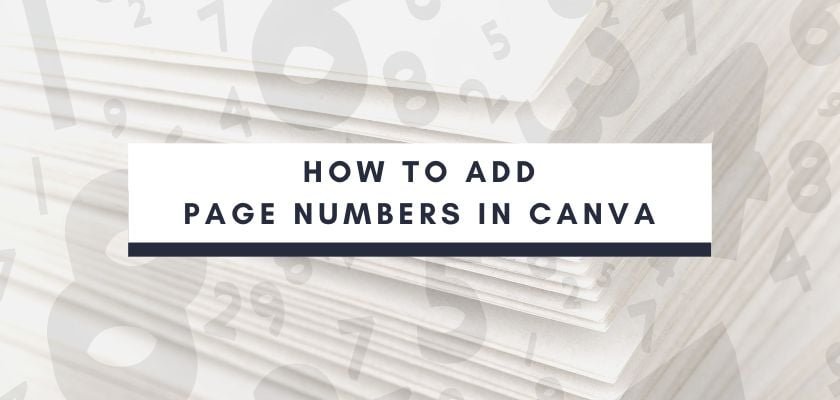Adding automatic page numbers is a game-changer for multi-page documents like e-books, workbooks, or presentations. It saves time and ensures consistent style across the whole document.
Many tools like Word, InDesign, and Adobe Acrobat Reader have this handy feature.
But what about Canva? What do you do to number pages in Canva?
How to Add Page Number in Canva
As of 2023, you cannot add page numbers automatically in Canva. With more people using Canva for long documents, I really hope this time-saving feature gets added soon. I’ll definitely keep you posted.
Don’t worry, though, if you need to add numbers to your Canva design. I’ve got some tips and seven ready-made Canva templates to speed things up for you.
Here are some ways to add page numbers to a Canva design:
- Simple: Add a text box with a number at the page bottom. Style it as you wish, then duplicate it throughout the document. To make things easy for you, I have created ready Canva templates for you to use (see below)!
- Element Numbers: In Canva’s Elements, you can search for number styles. Although there are some free options, Canva Pro users get a broader selection. However, I suggest using these for larger formats, like chapter numbers, rather than page numbers.
- Creative: If you’re feeling creative, design a unique page footer for your numbers using text boxes, shapes, and other design elements. As a Pro user, the sky’s the limit.
- Ready-made templates: The easiest way to get page numbers to your design is to use my ready that I’m sharing in this article. I’ve crafted a total of seven templates you can download in the end of this post. They’re totally free and no subscription is required. I will share the links and previews below in this post.
7 Page Number Design Ideas + Canva Template
Whether you choose to use my Canva templates or not, check out the previews for inspiration.
There are seven unique templates in total. These vary from a simple number at the bottom to design-focused page footers. The latter can be used for branding or achieving a more sophisticated look.
Idea #1: Elegant With Website URL

This page footer is simple yet elegant, featuring your website URL in the bottom left corner and the page number in the right.
Idea #2: Minimalist With Document Name

This footer is quite simple. It features your document title, which can be replaced with your website, alongside a page number. The text is set to be centered by default, but feel free to align it to the left or right as per your preference.
Idea #3: Simple Page Number

This is the easiest way to add page numbers. I’ve included it so you can see how basic page numbering can look. It’s totally fine to keep things simple. In the end, it all depends on your design and if this simple style is what you want.
Idea #4: Bold & Eye-Catching

This next idea is quite different; it’s bold and eye-catching, best suited for shorter documents. Consider using it if your design features ample white space, minimal text, and is primarily visually-oriented.
Idea #5: Aesthetic V.1

Now we are getting to more complex footer designs. This particular style complements color-filled pages well, like this beige example. Feel free to experiment with different colors. However, note that the graphic element (that geometric pattern) is a PRO element. While I’ve aimed to use only free fonts, it’s challenging to find quality free elements that truly enhance designs.
Here is a handpicked list of aesthetic fonts in case you need some options.
Idea #6: Aesthetic V.2

Here’s another aesthetically pleasing footer with page numbers. It’s essentially the same design as the previous one, but with a twist. I’ve altered the colors and swapped the pattern to demonstrate how just a few changes can significantly transform the entire design.
Idea #7: Modern & Informative

Finally, we’ve reached the last design. It’s modern, eye-catching, and informative.
I hope you’ve found my ideas helpful and will make use of the template I created for you. The link to the template with all the 7 numbered pages I showed you in examples is at the very end of this post.
In case you need some guidance how to manually number pages in Canva, here is a guide on how to do it the easiest way.
How to Number Pages in Canva: An Easy Guide
Firstly, create a sample content page with a page number at the bottom. Once you’re happy with the design, just duplicate the sample page as many times as needed. Then, adjust the page number to correspond with each page.
This method works best if you’re well-organized, knowing the exact number of pages you’ll need and their contents.
However, if your design process is more spontaneous and evolves as you create (this is definitely my way), here’s what I suggest:
- Begin by designing a page footer where the pagination will be. Typically, you might want to include details like your workbook’s name or your website URL alongside the page numbers.
- When the footer design meets your satisfaction, select all its elements and group them. This grouping will make copying and pasting easier on subsequent pages.
- Use the ‘Ctrl+C’ keyboard shortcut, or right-click and choose ‘Copy.’
- Next, go to another page that needs the footer. Make sure the bottom area of this page is visible on your screen – that’s crucial!
- Paste the footer by pressing ‘Ctrl+P’, or right-click and select ‘Paste.’ If the page’s bottom wasn’t visible when you pressed ‘Ctrl+P,’ your footer might get pasted atop the previous page’s footer or in the middle of the current page. If that happens, just delete the elements or hit the ‘Undo’ arrow.
- Repeat this process on all pages that need page numbers.
- Once done, go to each page and manually change the numbers.
Though it might seem daunting, it’s pretty straightforward once you get the hang of it. Just take it step by step, and you’ll have your pages numbered quite quickly!
I put considerable amount of effort into creating free Canva templates & printables, as well as Canva guides, how-tos, and tutorials. If you found this post useful and plan to use my free resources, please consider sharing this post (or any other) with your friends or colleagues. Your support makes all the difference. Thank you.






